Everyone nods at the timeline. Marketing needs assets by March 15th, development promises features by April 1st, sales wants demos by April 10th — then 3 weeks in, you discover the design team is still waiting for requirements that depend on research nobody started. This isn’t bad luck; it’s what happens when good intentions replace actual project scheduling.
This guide breaks down how project scheduling works in practice — from core concepts like task dependencies and duration estimates to more advanced techniques like critical path optimization and automated updates. You’ll learn techniques that prevent resource conflicts, adapt when priorities shift, and keep cross-functional teams aligned in a single visual workspace.
Try monday work managementKey takeaways
- Decompose deliverables into specific tasks with clear boundaries, duration estimates, and assigned owners to prevent work from falling through the cracks.
- Identify which tasks must happen in sequence and which can run parallel to avoid bottlenecks and keep your team moving forward efficiently.
- Use Gantt charts and automated workflows to turn static timelines into living coordination systems where teams see connections and adjust plans in real-time.
- Identify the longest sequence of dependent tasks that determines project duration, then concentrate resources and attention on these make-or-break activities.
- Visual work platforms transform scheduling from administrative overhead into strategic coordination by automating status changes, deadline reminders, and progress reports so teams spend time executing instead of managing.
What is project scheduling?
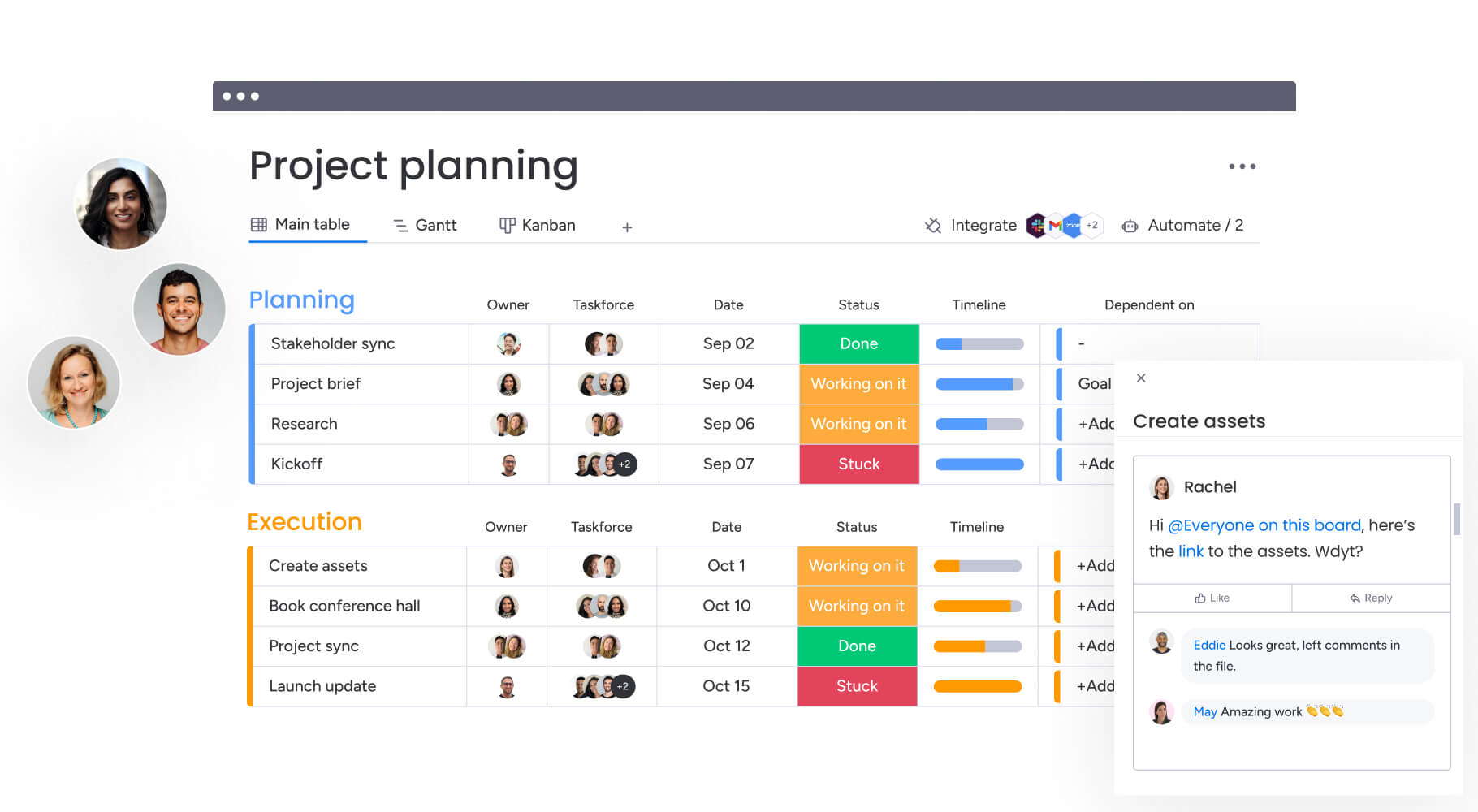
Project scheduling is the process of defining when project tasks will be completed, who is responsible for them, and how they relate to one another. It turns big-picture goals into an actionable roadmap by assigning timelines, resources, and dependencies to every piece of work.
Think of project scheduling as your project’s GPS. It doesn’t just show the destination — it maps out the entire journey, warns you about traffic jams before you hit them, and recalculates when you inevitably take a detour. When marketing teams launch campaigns, schedules ensure content creators finish drafts before editors review them. In construction, schedules prevent crews from attempting to install electrical systems before walls exist.
These dependencies aren’t optional. They determine whether projects succeed or fail. Across more than 300 billion-dollar megaprojects reviewed by McKinsey, the average cost overrun was approximately 80% and the average schedule delay about 50%, emphasizing that sequencing, dependencies, and critical-path control are decisive for outcomes.
A collaborative work platform transforms scheduling from static documents into a living coordination system where teams can see task dependencies, track progress, and adjust plans as conditions change. Increasingly, teams rely on AI-powered scheduling tools to refine estimates, surface risks early, and automatically adjust plans as conditions change.
Project scheduling vs. project planning
Project planning and project scheduling are closely related but serve different purposes — and confusing them is a common reason projects fail. Planning sets the vision and strategy; scheduling makes it happen. Teams that understand this distinction waste less time and execute more effectively.
- Project planning defines what the project will accomplish, why it matters, and what success looks like. It establishes scope, objectives, budget parameters, and strategic alignment.
- Project scheduling determines when specific work will happen, who will do it, and in what order.
For example, a product launch plan might define the target market, feature set, and success metrics. The project schedule takes that plan and creates a week-by-week timeline showing when product teams build features, when marketing creates campaigns, and when everything converges for launch day. Planning asks “what and why,” while scheduling answers “when and how.”
This distinction matters because teams need both to succeed. A brilliant plan without a realistic schedule remains theoretical. A detailed schedule without planning creates busy work that doesn’t advance strategic goals.
Understanding project scheduling fundamentals
Project scheduling rests on 3 interconnected principles that shape how teams execute work efficiently:
- Task decomposition: Schedules decompose complex work into discrete tasks with defined boundaries. Each task has a start point, end point, and specific deliverable.
- Time visibility: Schedules make time visible by assigning duration estimates and deadlines to every task. This creates accountability and enables progress tracking.
- Relationship mapping: Schedules expose relationships between tasks, showing which work must happen sequentially and which can occur in parallel.
These fundamentals apply universally. A software development team scheduling a feature release identifies coding tasks, testing phases, and deployment steps as discrete units. They estimate each task’s duration based on complexity and available developer hours. They map dependencies so testing can’t start until coding finishes. This structure prevents teams from discovering halfway through that they’ve sequenced work incorrectly.
Example: A simple project schedule in action
Imagine a simple project scheduling example for a 4-week website launch:
- Finalize requirements (3 days): Must finish before design starts
- Design homepage (5 days): Depends on requirements
- Develop homepage (7 days): Depends on design
- QA testing (3 days): Depends on development
- Launch approval (0 days): Milestone
Because each task depends on the previous one, this sequence forms the project’s critical path. Any delay to design or development pushes the launch date. Visual scheduling tools make these dependencies explicit, helping teams see where delays matter — and where they don’t.
Essential components of a project schedule
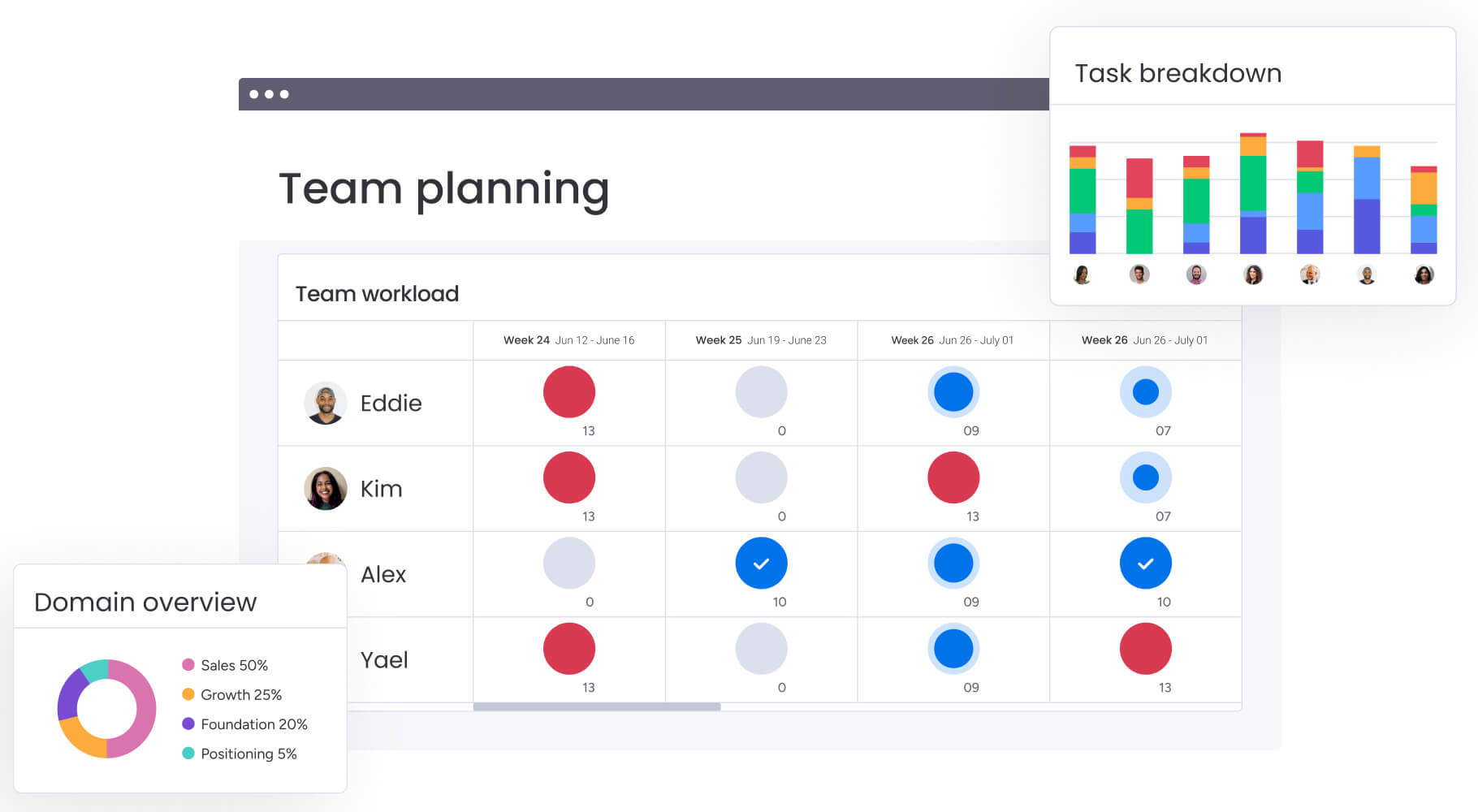
Great project schedules aren’t just pretty Gantt charts — they’re built on core elements that turn strategy into action. Master these building blocks and you’ll create schedules that actually drive work forward instead of collecting dust in shared folders.
Tasks, milestones, and deliverables
Understanding the distinction between these 3 elements helps teams structure schedules effectively:
| Component | Definition | Duration | Example |
|---|---|---|---|
| Work item | Individual work activity with defined boundaries | Has duration (hours/days) | Design homepage mockup |
| Milestone | Significant checkpoint or decision point | Zero duration | Design approval received |
| Deliverable | Tangible output that tasks produce | Not applicable | The actual design file |
Tasks represent work activities that team members can complete independently. Milestones mark significant project checkpoints without consuming time themselves. Deliverables are the tangible outputs that tasks produce and milestones validate.
Dependencies and task relationships
Dependencies define the logical relationships between tasks that determine sequencing and timing. Understanding dependency types helps teams model workflows accurately and identify where schedule compression is possible.
The most common dependency types include:
- Finish-to-start: Task B cannot begin until Task A completes
- Start-to-start: Tasks can begin simultaneously, though one may need a head start
- Finish-to-finish: Tasks must complete together, even if they start at different times
- Start-to-finish: Rare but important for scenarios like shift handoffs
Resources and team assignments
Resources encompass the people, equipment, and materials required to complete project work. Effective resource planning prevents the common scheduling mistake of assuming unlimited availability.
Resource conflicts occur when schedules assign the same resource to multiple tasks simultaneously. Visual workload tools make these conflicts visible before they cause problems, enabling teams to adjust timelines or reassign work. Skill-based assignments match tasks to team members based on capabilities, not just availability, balancing skill development opportunities with project risk tolerance.
7 steps to create your project schedule
Creating a solid schedule isn’t about filling in template boxes — it’s a deliberate progression from big-picture thinking to nuts-and-bolts execution. Follow these steps in order and you’ll avoid the classic pitfall of beautiful schedules that collapse on first contact with reality.
Step 1: Define project scope and objectives
Project scope establishes boundaries for what the project will and won’t accomplish. But how do you set those boundaries effectively? A strong scope statement identifies specific deliverables, success criteria, and explicit exclusions.
A clear scope definition includes:
- Specific deliverables: For a website redesign, scope might include “Redesign 15 core pages with responsive layouts” but exclude “Migrate blog content”
- Success criteria: Measurable outcomes that define project completion
- Explicit exclusions: What the project will not address to prevent scope creep
Objectives translate scope into measurable outcomes. Instead of vague goals, effective objectives specify “Reduce homepage load time to under 2 seconds” or “Increase mobile conversion rate by 15%.” These measurable targets inform scheduling decisions.
Step 2: Create your work breakdown structure
A work breakdown structure (WBS) decomposes project deliverables into progressively smaller components until reaching actionable tasks. The top level represents the complete project. The second level breaks it into major deliverables or phases. Subsequent levels continue subdividing until reaching tasks individuals can complete.
The WBS provides multiple benefits, including:
- Ensuring completeness: Systematically decomposing each deliverable prevents overlooked work
- Enabling accurate estimation: Breaking work into assessable chunks improves duration estimates
- Facilitating assignments: Creates tasks at the right granularity for individual ownership
Step 3: Identify task dependencies
Dependencies determine the sequence in which work must occur. Start by identifying mandatory dependencies that reflect physical or logical constraints. Code must be written before testing. Designs need approval before implementation begins.
Three types of dependencies require attention:
- Mandatory dependencies: Physical or logical constraints that cannot be changed
- Discretionary dependencies: Preferred sequences based on best practices
- External dependencies: Coordination requirements with parties outside the project team’s control
Step 4: Estimate accurate durations
Duration estimation determines how long each task will take, accounting for skill level, availability, and competing priorities. Accurate estimates come from historical data, expert judgment, and honest assessment of current team capacity.
Common estimation mistakes include confusing effort with duration and ignoring learning curves. Sixteen hours of work doesn’t mean 2 days if someone works on multiple projects. New team members need more time than experienced ones.
Step 5: Assign the right resources
Resource assignment matches tasks to people, equipment, and materials, transforming abstract schedules into executable plans. Effective assignment considers capability, availability, and suitability.
Resource leveling addresses conflicts when initial assignments overload team members. Specialized platforms help teams balance workloads and allocate resources based on skills and availability, ensuring the right people work on the right projects at the right time.
Step 6: Optimize your critical path
The critical path is the longest sequence of dependent tasks determining minimum project duration. Any delay to critical path tasks delays the entire project. Identifying this path reveals where schedule compression efforts should focus.
Optimization techniques include:
- Fast-tracking: Executing sequential tasks in parallel by accepting increased risk
- Crashing: Adding resources to reduce task durations
- Resource reallocation: Moving skilled team members to critical path activities
Not all critical path tasks can be optimized. Some have fixed durations determined by external factors.
Step 7: Baseline and share your schedule
Schedule baselining creates a reference point for measuring actual progress. The baseline captures the approved schedule at project start, preserving original estimates and deadlines. As work progresses, the baseline enables variance analysis and improved future estimates.
Sharing schedules creates accountability and enables coordination. Team members understand their assignments. Executives gain visibility into project status. Cross-functional partners know when to provide inputs or expect deliverables.
Try monday work management4 common project scheduling techniques
One-size-fits-all scheduling rarely works in practice. A 5-person marketing campaign needs different tools than a 200-person construction project. Pick your approach based on team size, how much uncertainty you’re facing, and how your organization actually works — not just what the textbook recommends.
| Project type | Team size | Best technique | Why it works |
|---|---|---|---|
| Marketing campaign | 5–15 people | Gantt chart | Sequential dependencies, stakeholder communication |
| Software development | 10–50 people | Agile scheduling | Evolving requirements, iterative delivery |
| Construction project | 50–200 people | Critical path method | Complex dependencies, fixed deadlines |
| Research initiative | 3–10 people | PERT | High uncertainty, probabilistic outcomes |
Gantt charts for visual timelines
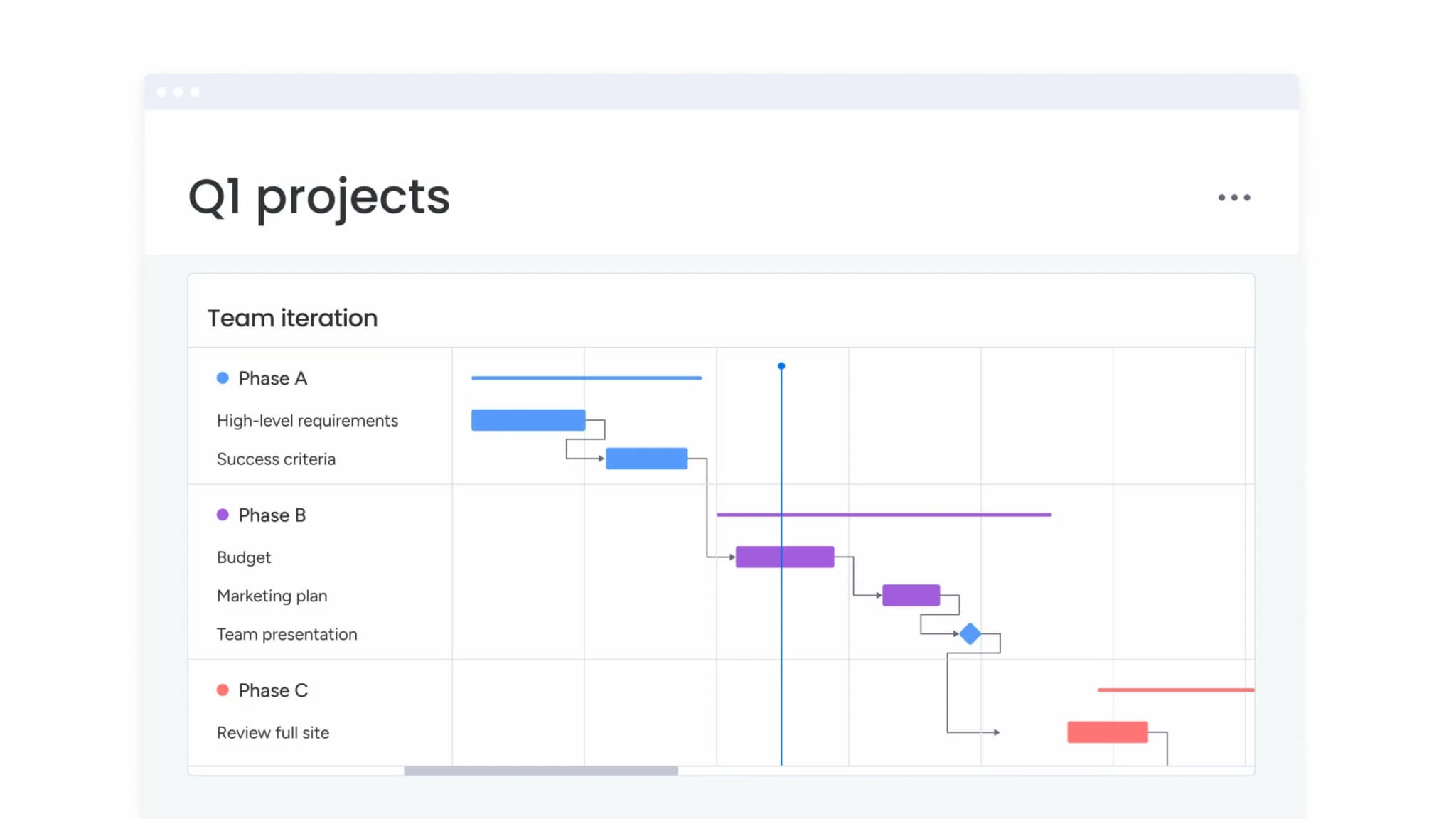
Gantt charts display schedules as horizontal bars on timelines, with each bar representing a task’s duration. Dependencies appear as arrows connecting related tasks. This visual representation makes schedules immediately comprehensible to diverse audiences.
Executives quickly assess project status without reading detailed reports. Team members see how their work fits the broader timeline. For example, monday work management’s Gantt view transforms complex schedules into intuitive visual timelines anyone can understand.
Critical path method for efficiency
Critical Path Method (CPM) identifies the longest sequence of dependent tasks determining project duration. By calculating early and late dates for each task, CPM reveals which tasks have scheduling flexibility and which must complete on time.
CPM enables sophisticated optimization by quantifying change impacts. If a critical path task reduces from 10 to 8 days, the entire project shortens by 2 days. Non-critical tasks with float can slip without affecting the timeline.
PERT for complex projects
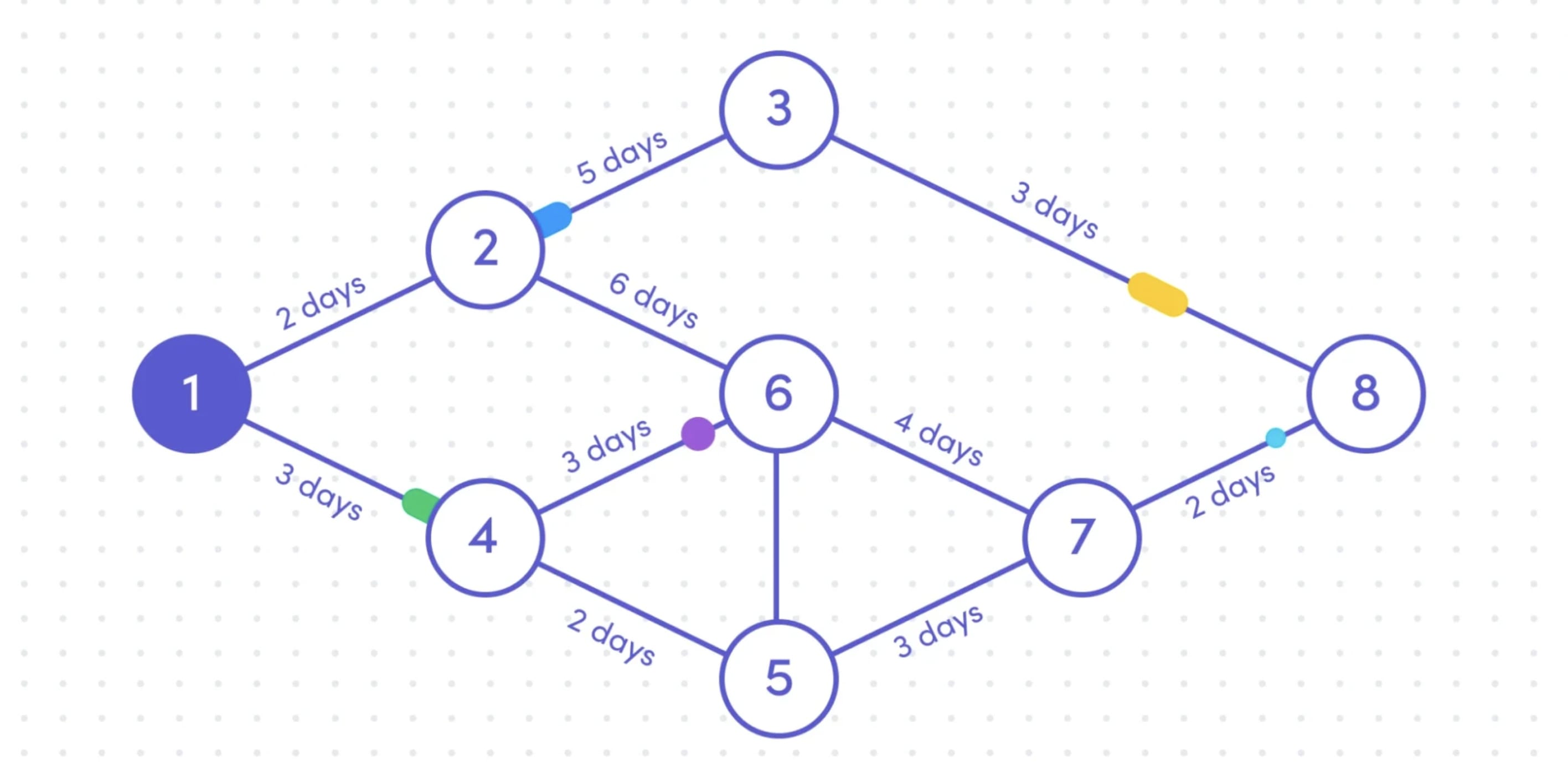
Program Evaluation and Review Technique (PERT) addresses scheduling uncertainty using probabilistic duration estimates. Teams provide optimistic, pessimistic, and most likely estimates for each task. PERT calculates expected durations and completion probabilities using these ranges.
PERT excels in environments with high uncertainty like research projects or first-of-a-kind initiatives. When teams genuinely don’t know task durations, PERT’s probabilistic approach acknowledges uncertainty rather than pretending false precision.
Agile scheduling for flexible teams
Agile scheduling breaks projects into short iterations of 1-4 weeks. Teams plan the next sprint in detail, maintain a prioritized backlog for future sprints, and adjust based on learning during each iteration. This technique works well when requirements evolve as teams learn.
For example, a software team building a new mobile app might start with a rough roadmap of features but plan only the next 2-week sprint in detail. As they complete each sprint, they learn what users actually need, adjust priorities, and plan the next iteration based on real feedback rather than initial assumptions.
Common challenges in creating a project schedule
Even seasoned project managers stumble over the same scheduling hurdles. The good news? These pitfalls are predictable. Spot them early and you’ll save yourself the painful mid-project realization that your timeline was built on wishful thinking rather than reality.
The most frequent scheduling challenges include:
- Inaccurate estimates: Overly optimistic timelines that don’t account for real-world complexity
- Resource conflicts: Multiple projects competing for the same team members
- Scope creep: New requirements added without adjusting timelines
- Poor communication: Stakeholders unaware of dependencies or timeline changes
- Inadequate tools: Manual methods that can’t handle cross-functional complexity
Modern scheduling platforms address these challenges through automated conflict detection, real-time updates, and visual dashboards that keep everyone aligned. When teams have the right tools and processes, they can anticipate and resolve issues before they impact delivery.
How monday work management makes project scheduling easier
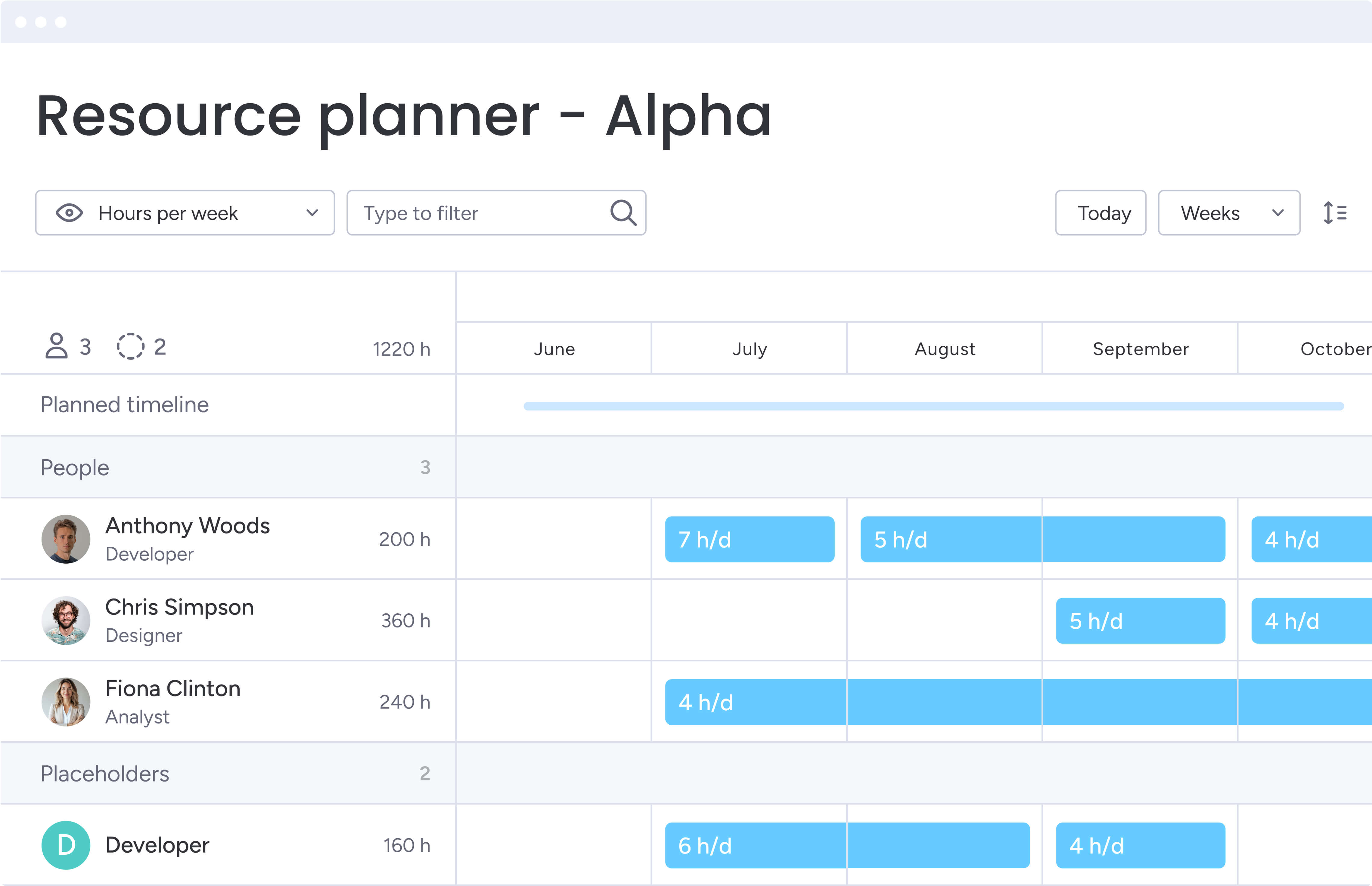
Nothing derails a perfect schedule faster than discovering your star designer is booked on 3 projects simultaneously. With monday work management’s resource planning tools, you can catch these conflicts before they become problems, showing you exactly who’s overloaded and where capacity exists across your entire organization.
Here’s how monday work management transforms resource scheduling:
- Workload view: See every team member’s assignments across all projects in one visual dashboard, with color-coded indicators showing who’s at capacity and who has bandwidth
- AI-powered capacity forecasting: monday AI analyzes historical patterns to predict resource needs weeks ahead, suggesting optimal allocation before conflicts emerge
- Automatic conflict alerts: Get instant notifications when someone’s assigned to overlapping tasks, with smart suggestions for rebalancing work
- Drag-and-drop reallocation: Shift assignments between team members visually and watch dependencies, timelines, and workloads adjust automatically
The platform’s visual interface makes resource management intuitive rather than analytical. You’re not crunching spreadsheets — you’re seeing your team’s capacity at a glance and making adjustments that ripple through connected schedules instantly.
Automations that keep schedules moving forward
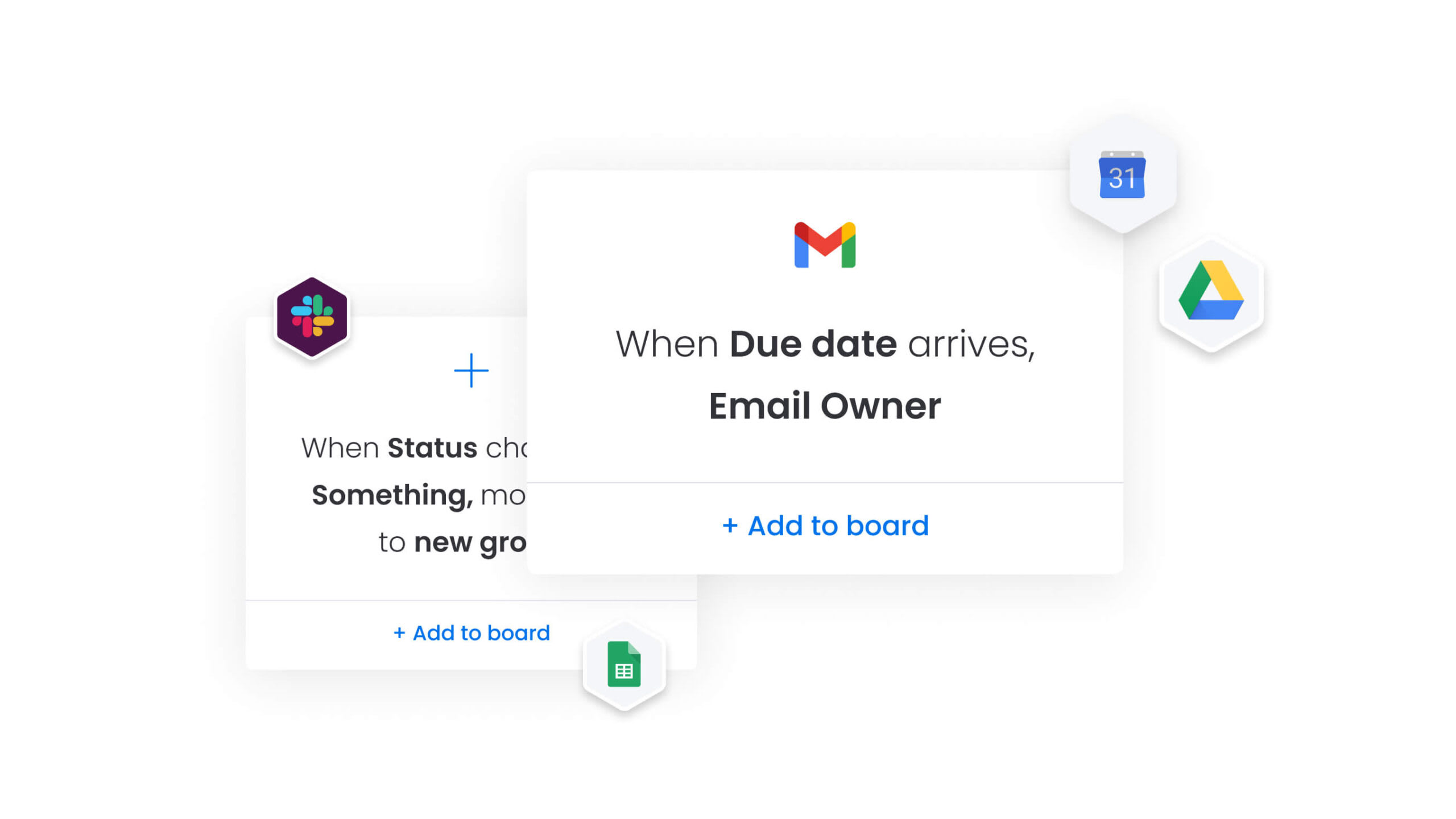
Nobody wants to spend their Friday updating project timelines or chasing people for status updates. Here’s how monday work management handles the administrative overhead automatically, so your team can focus on actual work instead of managing work:
- Smart status progression: Tasks automatically advance to the next stage when dependencies complete, triggering notifications to the right people at the right time
- Intelligent deadline reminders: The system sends contextual notifications as due dates approach, adjusting frequency based on task priority and team member workload
- Dependency-triggered workflows: When one task finishes, successor tasks automatically start, assignees get notified, and relevant stakeholders receive updates — no manual handoffs required
- AI-generated progress summaries: monday AI creates natural-language status reports by analyzing task completion, timeline adherence, and resource utilization across your projects
- Adaptive scheduling suggestions: When delays occur, AI recommends timeline adjustments and resource reallocations to keep projects on track
These automations work through no-code workflows anyone can configure in minutes. Set your rules once — like “notify the design team when development marks their task complete” — and the platform handles execution consistently. Team members get relevant updates without information overload. Stakeholders stay informed without constant status meetings. And you reclaim hours previously spent on coordination busywork.
Start building a project schedule that works
Effective project scheduling transforms how teams coordinate work and deliver results. When schedules connect strategic objectives to daily tasks, teams gain the visibility and structure needed to execute consistently. The right scheduling approach balances detailed planning with the flexibility to adapt as conditions change.
With monday work management, you can reimagine project scheduling as a visual, collaborative process that connects strategic planning to daily execution. Instead of scheduling being a specialized activity done in isolation, it becomes an intuitive capability where everyone sees how their work connects to broader objectives. Start building schedules that actually guide work rather than creating administrative overhead.
Try monday work managementFAQs
What are the 4 types of scheduling in project management?
In project management, the 4 main types of scheduling are time-based scheduling using calendars and timelines to sequence work, resource-based scheduling organizing work around availability and capacity, priority-based scheduling sequencing tasks by business value, and dependency-based scheduling sequencing work based on logical relationships between tasks.
How often should you update project schedules?
Project schedules should be updated whenever significant changes occur. This includes when tasks complete, delays emerge, resources change, or scope adjusts. For active projects, this typically means daily or weekly updates to task status and progress.
What's the difference between project scheduling and planning?
Project scheduling and planning serve different purposes. Planning defines what the project will accomplish, why it matters, and what resources are available. Scheduling determines when specific work will happen, who will do it, and in what sequence.
Which scheduling method works best for agile teams?
Agile teams typically use sprint-based scheduling. Work is planned in short 1-4 week iterations with detailed planning only for the immediate sprint and high-level planning for future work. This allows flexibility while maintaining structure.
Can you compress schedules without sacrificing quality?
Schedule compression is possible through fast-tracking and crashing techniques. Fast-tracking executes sequential tasks in parallel by accepting increased risk. Crashing adds resources to reduce task durations. Both involve trade-offs between time, cost, and risk that require careful evaluation.
How does AI improve scheduling accuracy?
AI improves scheduling accuracy by learning from historical project data to predict task durations, resource requirements, and potential risks. Instead of relying on individual experience, AI analyzes patterns from past projects to forecast how long similar work will take and which dependencies typically cause delays.
